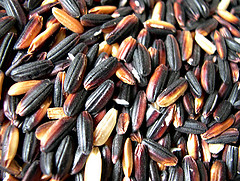A surprisingly detailed – for this kind of thing – article in the News-Journal describes efforts to preserve the breed of cattle known as the Texas Longhorn. This apparently developed from cattle introduced from Spain to what is now Mexico around 1500. It was the mainstay of the Texan cattle industry until railroads replaced the traditional cattle drive (much seen in John Wayne movies) at the end of the 19th century. Their long horns meant you could fit fewer of them into the cattle-trucks. It has since been much altered by cross-breeding, and, predictably, this loss of “purity” has upset some people, while no doubt leaving others to mutter “So what?”, probably under their breath. Anyway, there’s a registry, and a DNA database is underway. Lots more interesting detail in the article.
More tea, vicar?
You may remember an earlier – somewhat facetious – post on a possible threat to tea diversity in China. Now, from CropBiotech Update, there’s a summary of a far from facetious review paper on tea breeding in that country. Turns out that the China National Germplasm Tea Repositories can count on some 3000 tea germplasm accessions, and that over 200 improved varieties have been released. Some quite advanced biotechnological approaches are being used to speed up breeding. One of the things the researchers are looking at is developing cultivars with low or no caffeine, using RNAi. Personally, I think caffeine-free tea and coffee, like alcohol-free beer, are a bit like a one-legged man at a butt-kicking contest: useless. But the technology is cool.
Very diverse barley discovered … and already under threat?
SciDev.net reports on a paper in Theoretical and Applied Genetics that identifies the world’s most genetically diverse barley varieties. SciDev.net and other press reports focus on the high diversity of the barleys, found growing in farmers’ fields around the captial city of Asmara in Eritrea, as a source of potentially valuable material for improving tropical varieties worldwide. They point out, too, that the populations are threatened by urban development and that Eritrea has no genebank in which to protect them. But does Eritrea really need its own genebank, or have they more pressing priorities? A researcher from ICARDA, which has a perfectly serviceable genebank, was on the team. The International Treaty on Plant Genetic Resources for Food and Agriculture guarantees free access to the material if stored there. Eritrea was one of the first signatories of the Treaty. What’s the problem?
More interesting, perhaps, is a part of the paper that the reports I read neglected to mention. The molecular analysis indicates that the Horn of Africa may be where barley was first domesticated. That honour usually goes to the Fertile Crescent, with the Horn a “secondary centre of diversity”. But Eritrean and Ethiopian barley may actually have been domesticated independently.
Thai rice on the genebank menu
 There was a slightly odd article at Seed Magazine a little while back on Thailand’s efforts to conserve almost extinct varieties of rice in its genebank. Odd because while the story is familiar enough in this kind of piece, the details are slightly confused (or confusing). But no matter, that’s probably only of concern to a pedant like me. The rest of you won’t worry about statements like “farmers across Asia once grew more than 100 varieties of rice, but now that number is down to only 20 or 30 of the most productive types”. Instead, you’ll be thrilled to know that the Thai national collection houses nearly 24,000 varieties, 17,000 of which “are in danger of dying out because they are no longer grown by Thai farmers”. That’s great because SINGER, a window on the world of genebank accessions, lists only 5982 samples from Thailand. Maybe one of those is “the fragrant Pin Kaew variety that was named the best rice in the world at a competition in 1966 but which has since disappeared, having lost out to more productive varieties”.
There was a slightly odd article at Seed Magazine a little while back on Thailand’s efforts to conserve almost extinct varieties of rice in its genebank. Odd because while the story is familiar enough in this kind of piece, the details are slightly confused (or confusing). But no matter, that’s probably only of concern to a pedant like me. The rest of you won’t worry about statements like “farmers across Asia once grew more than 100 varieties of rice, but now that number is down to only 20 or 30 of the most productive types”. Instead, you’ll be thrilled to know that the Thai national collection houses nearly 24,000 varieties, 17,000 of which “are in danger of dying out because they are no longer grown by Thai farmers”. That’s great because SINGER, a window on the world of genebank accessions, lists only 5982 samples from Thailand. Maybe one of those is “the fragrant Pin Kaew variety that was named the best rice in the world at a competition in 1966 but which has since disappeared, having lost out to more productive varieties”.
flickr photo by Stef Noble used under a Creative Commons license. Purple Sticky Rice is rare, but not that rare.
Rice stories
The BBC World Service is broadcasting a series of four programmes on the rice cultures of Asia, called Rice Bowl Tales. Starts 28 February, but if you miss it, it seems like the series has already aired on Radio National, and if you follow the link I’ve just given, you should be able to listen online or download audio files.